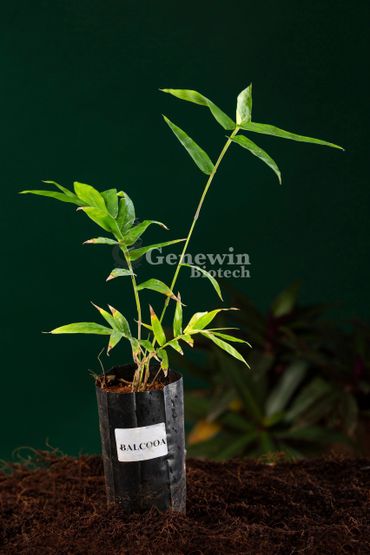Bambusa Balcooa Tissue culture bamboo plant

Common Name
- Trelồ ô (Vietnam)
- Balku bans (Bengal, India)
- Barak (Tripura, India)
- Boro bans (Duars, India)
- Baluka, Sil borua (Assam, India)
- Wamnah, Beru (Garo, India)
Uses and Applications
- Handicrafts
- Whole culms in construction
- Edible shoots
- Fodder
- Agricultural implements
- Incense sticks
- Soil erosion control
- Flood control
Additional Applications:
- Strand woven lumber
- Paper pulp
- Laminated bamboo
Commercial Uses:
- Plantations for fibre
- Biofuel production
- Biorefinery
- Charcoal production
Characteristics
- Evergreen, densely tufted bamboo
- Short-necked pachymorph rhizomes
- Culms height: 15 to 30 meters with arching tops
- Mature culms diameter: 8–15 cm
- Wall thickness:
- Base: 2.7–3.2 mm
- Middle: 1.2–2.0 mm
- Top: 0.3–0.7 mm
- Internode lengths:
- Base: 15.5–35 cm
- Middle: 38.0–41.0 cm
- Top: 30.0–36.0 cm
- Prominent nodes
- Strong branching with thorn-like branchlets at lower nodes
Distribution
Native Range:
• Indo-China: Laos, Myanmar, Vietnam
• Indian Subcontinent: Bangladesh, India, Nepal, Assam
Cultivation
Plantation Types:
• B. balcooa is cultivated in various plantation setups, including block, high-density, agroforestry, and strip plantations.
Spacing:
• In areas with low rainfall, the typical spacing is 4x4 meters.
• In high rainfall regions, a spacing of 5x5 meters is common.
• For intercropping, wider spacing such as 7x7 meters or 9x9 meters is usually preferred.
Harvest Maturation:
• This species reaches maturity and is ready for harvesting in 3 to 5 years.
Climatic Conditions
• Temperature Tolerance: B. balcooa thrives in temperatures ranging from -5°C to 20 °C, with the ability to endure up to 30 °C.
• Precipitation: Prefers areas with rainfall between 2500–5000 mm.
• Altitude Range: Typically found at elevations of 1000–1250 m, but also grows well at lower altitudes and sea level.
Soil:
• Favors heavy-textured soils with good drainage such as alluvial clay, sandy loam, deep, loose, fertile sandy loam, and sandy clay loam.
• Optimal soil pH ranges from 5.11 to 7.5.
Native Habitat
• Growing Regions: Prolific in flat lands and valleys, especially in areas with moderate to high rainfall.
Essential Ecosystem Benefits
- Widely cultivated globally, B. balcooa is ideal for large-scale plantations due to its easy propagation.
- Provides significant benefits for water conservation and erosion control.
- As a sterile species, it eliminates the risk of gregarious flowering and subsequent population die-off.
- High biomass productivity in optimal conditions offers promising opportunities for carbon trading.
Advantages of Tissue Culture Plants
- True to the type
- High market value & High yield and quality
- High biomass yielding plant
- Energy can be generated
- Throughout the year plantation possible
- Disease free Plants.
- Genetically pure and identical to mother plant.
- Uniform and high yield.
- Mass production at less time and at less cost.
- Season independent.
Bambusa Balcooa Photo Gallery





Copyright © 2025 Genewin Biotech - All Rights Reserved.
- About Us
- News & Resources
- Bambusa Nutans - Bamboo
- Bambusa Tulda - Bamboo
- Dendrocalamus Asper
- Dendrocalamus Brandisii
- Dendrocalamus Stocksii
- Thyrsostachys Oliveri
- G9 Grand Naine Banana
- Red Banana Plant
- Yelakki Banana Plant
- Ginger Varadha
- Black Turmeric plant
- Spider Plant
- Money Plant
- Social Media Updates
- Careers
- F.A.Q
- Privacy Policy
This website uses cookies.
We use cookies to analyze website traffic and optimize your website experience. By accepting our use of cookies, your data will be aggregated with all other user data.

